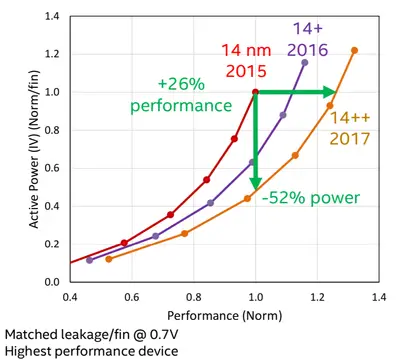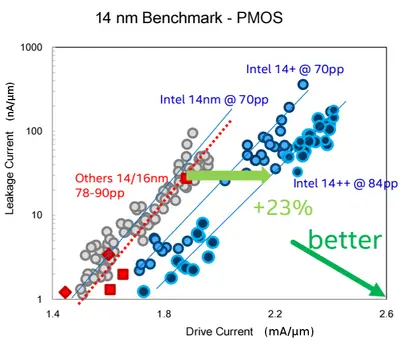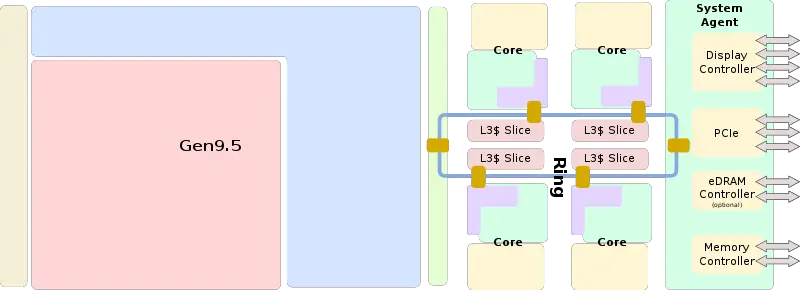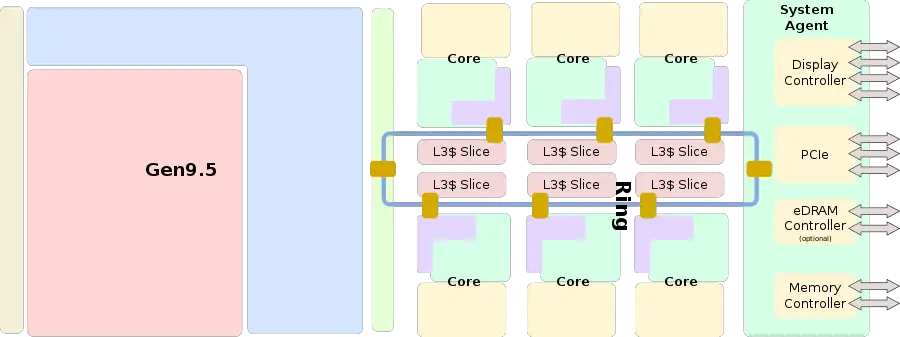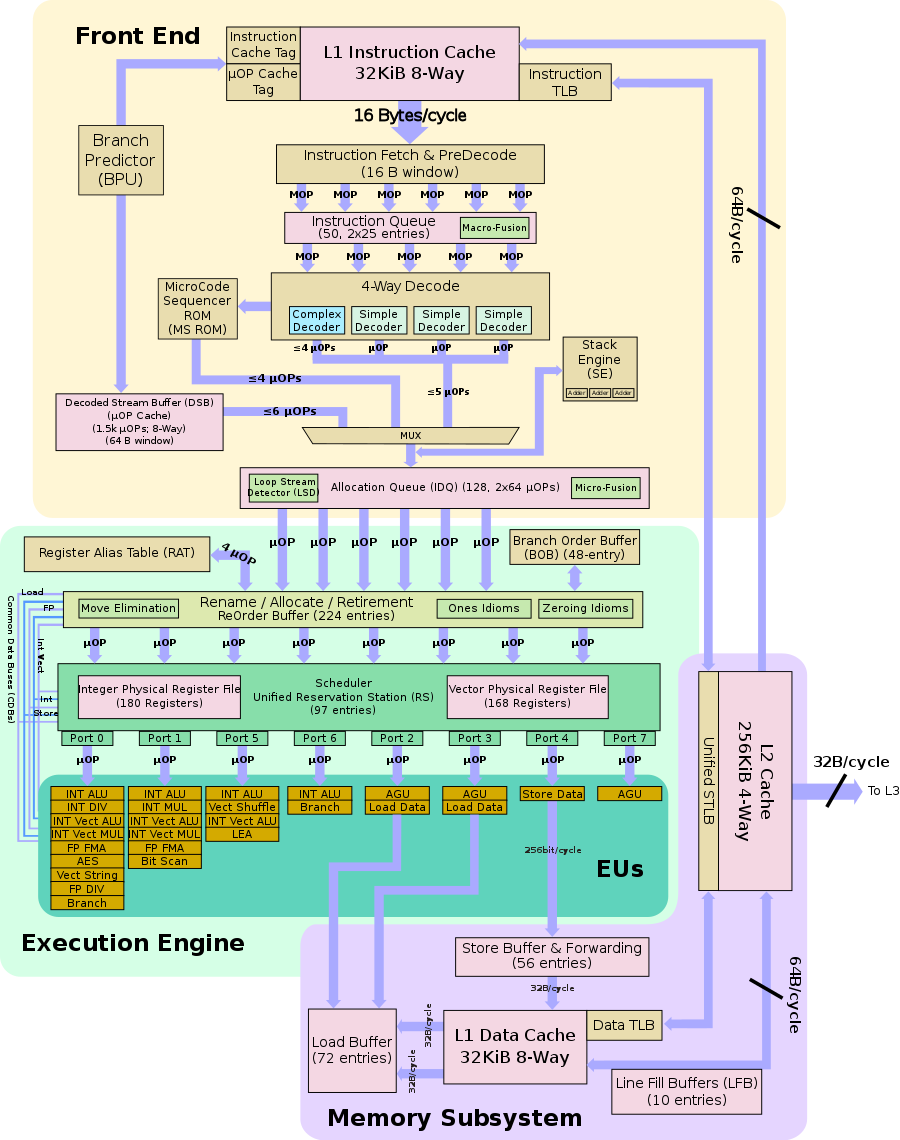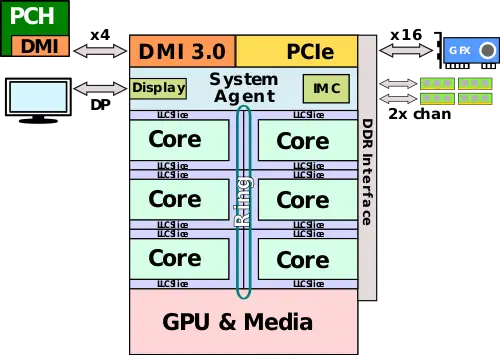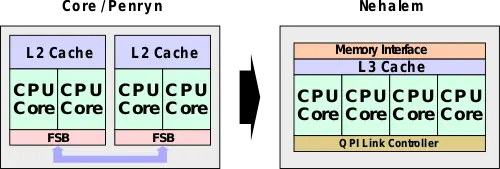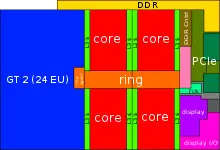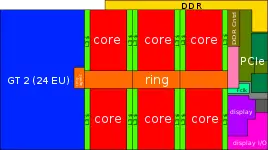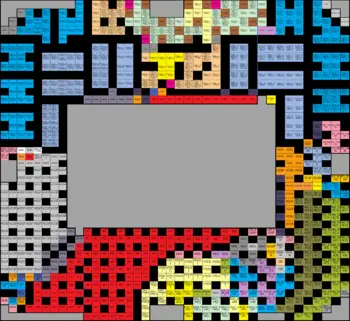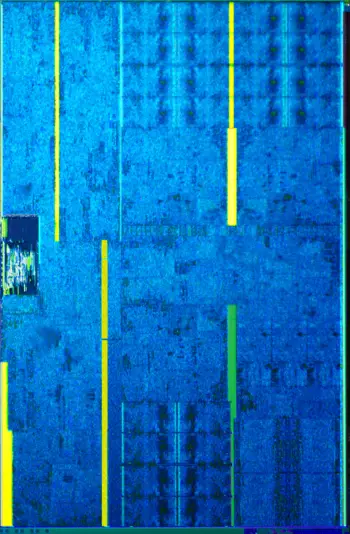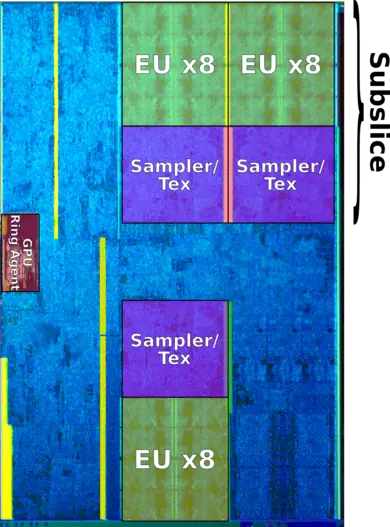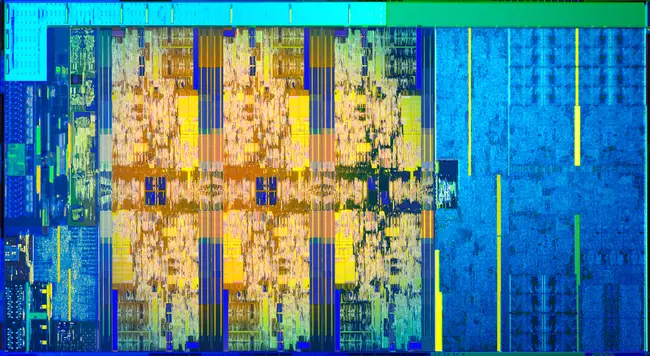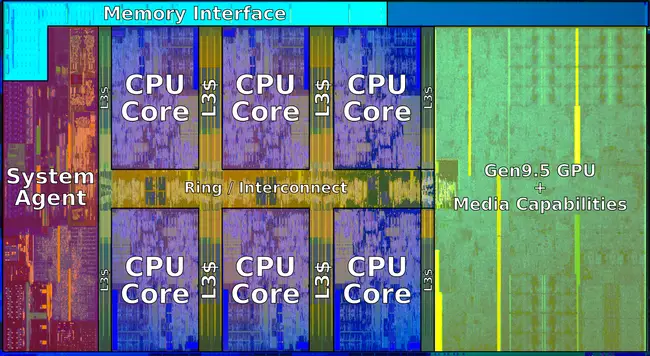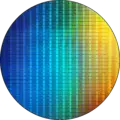(→Power delivery) |
|||
| Line 430: | Line 430: | ||
== Power delivery == | == Power delivery == | ||
| − | Despite using the same socket ({{intel|FCLGA-1151}}) Coffee Lake | + | Despite using the same socket ({{intel|FCLGA-1151}}) Coffee Lake breaks compatibility with {{\\|Skylake (client)|Skylake}} and {{\\|Kaby Lake}} due to various enhancements to the power delivery of the processor in order to better handle the additional cores. |
| − | In order to improve the power delivery of the chip and support higher package-level current delivered for the additional cores, Intel needed to increase the number of pins that go to the power rails of the die. Since there is a practical limit as to how much current each pin is capable of delivering, a large number of additional pins that were previously unused/reserved have also been allocated for this purpose. The new hexa-core parts have 38 higher amperage rating. | + | In order to improve the power delivery of the chip and support the higher package-level current delivered for the additional cores, Intel needed to increase the number of pins that go to the power rails of the die. Since there is a practical limit as to how much current each pin is capable of delivering, a large number of additional pins that were previously unused/reserved have also been allocated for this purpose. The new hexa-core parts have 38 higher amperage rating. |
{| class="wikitable" | {| class="wikitable" | ||
Revision as of 16:52, 24 November 2017
| Edit Values | |
| Coffee Lake µarch | |
| General Info | |
| Arch Type | CPU |
| Designer | Intel |
| Manufacturer | Intel |
| Introduction | October 5, 2017 |
| Process | 14 nm |
| Core Configs | 4, 6 |
| Pipeline | |
| OoOE | Yes |
| Speculative | Yes |
| Reg Renaming | Yes |
| Stages | 14-19 |
| Decode | 5-way |
| Instructions | |
| ISA | x86-16, x86-32, x86-64 |
| Extensions | MOVBE, MMX, SSE, SSE2, SSE3, SSSE3, SSE4.1, SSE4.2, POPCNT, AVX, AVX2, AES, PCLMUL, FSGSBASE, RDRND, FMA3, F16C, BMI, BMI2, VT-x, VT-d, TXT, TSX, RDSEED, ADCX, PREFETCHW, CLFLUSHOPT, XSAVE, SGX, MPX |
| Cache | |
| L1I Cache | 32 KiB/core 8-way set associative |
| L1D Cache | 32 KiB/core 8-way set associative |
| L2 Cache | 256 KiB/core 4-way set associative |
| L3 Cache | 2 MiB/core Up to 16-way set associative |
| L4 Cache | 128 MiB/package on Iris Pro GPUs only |
| Cores | |
| Core Names | Coffee Lake U, Coffee Lake H, Coffee Lake S |
| Succession | |
| Contemporary | |
| Cannonlake | |
Coffee Lake (CFL) is a microarchitecture designed by Intel as a successor to Kaby Lake for desktops and high-performance mobile devices. Coffee Lake was introduced in the third quarter of 2017 and is manufactured on Intel's mature 14 nm process. Coffee Lake features the first series of mainstream hexa-core processors from Intel.
Contents
Codenames
| Core | Abbrev | Description | Graphics | Target |
|---|---|---|---|---|
| Coffee Lake U | CFL-U | Ultra-low power | GT2 | Light notebooks, portable All-in-Ones (AiOs), Minis, and conference room |
| Coffee Lake H | CFL-H | High-performance graphics | GT3e | Ultimate mobile performance, mobile workstations |
| Coffee Lake S | CFL-S | Mainstream performance | GT2 | Desktop performance to value, AiOs, and minis |
| Coffee Lake X | CFL-X | Extreme Performance | High performance desktops |
Brands
Intel released Coffee Lake under 3 main brand families:
| Logo | Family | General Description | Differentiating Features | |||||
|---|---|---|---|---|---|---|---|---|
| Cores | HT | AVX | AVX2 | TBT | ECC | |||
 |
Core i3 | Low-end Performance | Quad | ✘ | ✔ | ✔ | ✘ | ✘ |
 |
Core i5 | Mid-range Performance | Hexa | ✘ | ✔ | ✔ | ✔ | ✘ |
 |
Core i7 | High-end Performance | Hexa | ✔ | ✔ | ✔ | ✔ | ✘ |
Release Dates
Early roadmaps indicated Coffee Lake was to be introduced around the second quarter of 2018. In early 2017 Intel announced that 8th generation processors will be available starting from the 3rd quarter of 2017. While the exact reason for the early release is unknown, it seems likely to attribute the move to various market forces, particularly AMD's introduction of Zen and the Ryzen family.
Intel announced Coffee Lake-based SKUs on September 24 with products available beginning October 5, 2017 and OEM systems starting Q4 2017.
Technology
- See also: Broadwell § Process Technology and 14 nm lithography process
Coffee Lake is manufactured on Intel's 3rd generation 14 nm process called "14nm++". The process is the second enhanced version of the first which was used for the Broadwell microarchitecture (first enhanced version was first used for Kaby Lake). The various enhancements improve performance without increasing the capacitance (i.e., active power characteristics). 14nm++ allows for +23-24% higher drive current. Intel claims their 14nm++ process provides 26% more performance for 52% less power.
Note that while both "14nm" and "14nm+" used the same transistor geometry, the "14nm++" actually uses a more relaxed contacted poly pitch of 84 nm (from previously 70nm). There is no real density change despite this change likely due to various design techniques such as reduced fins where unnecessary.
| Kaby Lake | Coffee Lake | Δ | |
|---|---|---|---|
| 14 nm | 14 nm | ||
| Gate Pitch | 70 nm | 84 nm | 1.20x |
| Interconnect Pitch | 52 nm | 52 nm | 1.00x |
Compatibility
| This section is empty; you can help add the missing info by editing this page. |
Compiler support
| Compiler | Arch-Specific | Arch-Favorable |
|---|---|---|
| ICC | -march=skylake |
-mtune=skylake
|
| GCC | -march=skylake |
-mtune=skylake
|
| LLVM | -march=skylake |
-mtune=skylake
|
| Visual Studio | /arch:AVX2 |
/tune:skylake
|
CPUID
| Core | Extended Family |
Family | Extended Model |
Model |
|---|---|---|---|---|
| U | 0 | 0x6 | 0x9 | 0xE |
| Family 6 Model 158 | ||||
| S/H | 0 | 0x6 | 0x? | 0x? |
| Family 6 Model ??? | ||||
Architecture
While there is no change in pure IPC over Skylake and the actual microarchitecture is largely the same, Intel introduced a number of major architectural changes in Coffee Lake. In addition to improved performance brought by the uplift in binning as a result of the enhanced process, Coffee Lake also increased the number of cores by 50%, enabling much higher multi-threaded performance. The enhanced manufacturing process should allow Coffee Lake chips to be highly overclockable.
Key changes from Kaby Lake
- Enhanced "14nm++" process results in higher turbo frequencies
- IPC improvement from larger cache for various workloads, but actual core is unchanged
- System Architecture
- 50% more cores (6, from 4)
- 50% larger last level cache (up to 12 MiB, from 8 MiB)
- Core
- LSD has been re-enabled (Previously disabled)
- Chipset
- 200 Series chipset → 300 Series chipset (Cannonlake PCH)
- Memory
- Faster memory for mainstream desktops (i.e., Coffee Lake S) DDR4-2666 (from DDR4-2400)
- Graphics
- Gen 9.5 GPUs (No Change)
- HD Graphics 6x0 → UHD Graphics 6x0 (Branding change only)
- HD Graphics 630 → UHD Graphics 630 (No change)
- Families
- Core i3 gained 100% more cores (4, from 2) but dropped hyper-threading support
- Core i5 gained 50% more cores (6, from 4)
- Core i7 gained 50% more cores (6, from 4)
Block Diagram
Entire SoC Overview (quad)
Entire SoC Overview (hexa)
Individual Core
(Core identical to Skylake (client))
Gen9.5
See Gen9.5#Gen9.5.
Memory Hierarchy
The overall memory structure is identical to Skylake.
- Cache
- L0 µOP cache:
- 1,536 µOPs, 8-way set associative
- 32 sets, 6-µOP line size
- statically divided between threads, per core, inclusive with L1I
- 1,536 µOPs, 8-way set associative
- L1I Cache:
- 32 KiB, 8-way set associative
- 64 sets, 64 B line size
- shared by the two threads, per core
- 32 KiB, 8-way set associative
- L1D Cache:
- 32 KiB, 8-way set associative
- 64 sets, 64 B line size
- shared by the two threads, per core
- 4 cycles for fastest load-to-use (simple pointer accesses)
- 5 cycles for complex addresses
- 64 B/cycle load bandwidth
- 32 B/cycle store bandwidth
- Write-back policy
- L2 Cache:
- Unified, 256 KiB, 4-way set associative
- Non-inclusive
- 1024 sets, 64 B line size
- 12 cycles for fastest load-to-use
- 64 B/cycle bandwidth to L1$
- Write-back policy
- L3 Cache/LLC:
- Up to 2 MiB Per core, shared across all cores
- Up to 16-way set associative
- Inclusive
- 64 B line size
- Write-back policy
- Per each core:
- Read: 32 B/cycle (@ ring clock)
- Write: 32 B/cycle (@ ring clock)
- 42 cycles for fastest load-to-use
- Side Cache:
- System DRAM:
- 2 Channels
- 8 B/cycle/channel (@ memory clock)
- 42 cycles + 51 ns latency
- L0 µOP cache:
Coffee Lake TLB consists of dedicated L1 TLB for instruction cache (ITLB) and another one for data cache (DTLB). Additionally there is a unified L2 TLB (STLB).
- TLBs:
- ITLB
- 4 KiB page translations:
- 128 entries; 8-way set associative
- dynamic partitioning
- 2 MiB / 4 MiB page translations:
- 8 entries per thread; fully associative
- Duplicated for each thread
- 4 KiB page translations:
- DTLB
- 4 KiB page translations:
- 64 entries; 4-way set associative
- fixed partition
- 2 MiB / 4 MiB page translations:
- 32 entries; 4-way set associative
- fixed partition
- 1G page translations:
- 4 entries; fully associative
- fixed partition
- 4 KiB page translations:
- STLB
- 4 KiB + 2 MiB page translations:
- 1536 entries; 12-way set associative
- fixed partition
- 1 GiB page translations:
- 16 entries; 4-way set associative
- fixed partition
- 4 KiB + 2 MiB page translations:
- ITLB
- Note: STLB is incorrectly reported as "6-way" by CPUID leaf 2 (EAX=02H). Coffee Lake erratum CFL084 recommends software to simply ignore that value.
Overview
The Coffee Lake system on a chip consists of a five major components: CPU cores, LLC, Ring interconnect, System Agent, and the integrated graphics. The core architecture in Coffee Lake, like in Kaby Lake, as not changed from Skylake. This is also true for the integrated graphics which is identical to the one incorporated in Kaby Lake and from a platform point of view, the I/O has not changed (supporting up to 3 displays and providing 16 PCIe Gen 3 lanes). Coffee Lake, however, has brought a relatively large change to the overall system architecture by introducing two additional physical cores into its mainstream processor die. Those two cores also come with up to 2 MiB of LLC slice per core (for up to 4 MiB of additional last level cache).
In addition to improving multi-thread performance considerably by introducing 50% or two more cores as well as up to four additional threads, the added addition of up to 4 MiB of cache should have a positive impact on most single-thread performance.
Historical Trend
Coffee Lake presents the largest change in the system architecture of Intel's mainstream microarchitecutre since the introduction of Sandy Bridge in 2011. In 2006 Intel introduced the first mainstream quad-core processor, the Core 2 Extreme QX6700 which was based on the Kentsfield core. Those initial quad-cores comprised of two separate dies interconnected in a multi-chip package. A coherent communication link was lacking and the aging front-side bus was used for as the die-to-die link. This configuration did not change through Penryn up until the introduction of the Core i7 Extreme based on the Nehalem microarchitecture in 2008. Nehalem leveraged Moore's Law and Intel's 45 nm process to incorporate all four cores onto a single die along with a large number of changes, particularly enhancing the uncore (now known as the System Agent).
With the introduction of Sandy Bridge in 2011, the entire system architecture was reworked. A particular goal of Sandy Bridge was its configurability. Intel wanted to be able to use a single design across multiple market segments without having to spend extra resources on multiple physical designs. A large part of its modularity came from the ring interconnect Sandy Bridge implemented. It's worth pointing out that the ring implementation in Sandy Bridge is an enhanced version largely based on an implementation first incorporated into the Nehalem-EX server parts. The ring allowed Intel to integrate the System Agent and the integrated graphics on-die in Sandy Bridge.
Each of those components had its own ring agent (in addition to the individual core), allowing for efficient transfer of data between the GPU, the SA, and the individual cores and caches. The final result was a complete system on a chip with four cores and a 12 EU GPU on a single die measuring consisting of 1.16 billion transistors on a 216 mm² die.
From Sandy Bridge through 22 nm Haswell and through 14 nm Skylake, the die shrunk considerably, even after large amount of enhancements (and thus transistors) were done to the microarchitecture. With the aid of Moore's Law, the quad-core die in Coffee Lake's predecessor, Kaby Lake, has reached 126 mm² - 42% smaller than the quad-core Sandy Bridge while packing over 3 times as much transistors.
Since Coffee Lake utilizes Intel's 3rd generation enhanced 14nm++ process which has reached maturity and healthy yield, Intel can afford to increase the amount of cores by 50% from 4 to 6 cores. This is also possible thanks to the existing ring interconnect that was designed specifically to be able to support this configuration. In addition to the two added cores, there are two addition LLC slices - each consisting of 2 MiB in size.
It can easily be seen how the natural evolution of Moore's Law and its affects on the die size of Intel's mainstream platform enables the addition of two more cores and their associated cache slices without sacrificing yield due to a bigger die. In fact, the hexa-core at 149 mm² is still considerably smaller than even the quad-core Haswell-based chips. The pair of cores with their associated cache slices contributed an extra ~25mm². In fact, it can further be seen that even an 8-core Coffee Lake would be smaller than Haswell's quad-core at around 174 mm². It's worth noting that Coffee Lake is released concurrently with Cannonlake which is a 10 nm-based microarchitecture for low-power mobile devices. Due to Intel's faithful die shrink of roughly x2.7 in density, an identical hexa-core Coffee Lake die on 10nm would result in a smaller die than any of the 14 nm quad-core dies, possibly even the dual-core dies as well.
Core
Pipeline
- Main article: Skylake § Pipeline
Coffee Lake's pipeline is identical to Skylake's.
Front-end
Note that a bug associated with the Loop Stream Detector (LSD) has been fixed with Coffee Lake. See Skylake (server) § Front-end.
Scheduler Ports & Execution Units
| Scheduler Ports Designation | |
|---|---|
| Port 0 | Integer/Vector Arithmetic, Multiplication, Logic, Shift, and String ops |
| FP Add, Multiply, FMA | |
| Integer/FP Division and Square Root | |
| AES Encryption | |
| Branch2 | |
| Port 1 | Integer/Vector Arithmetic, Multiplication, Logic, Shift, and Bit Scanning |
| FP Add, Multiply, FMA | |
| Port 5 | Integer/Vector Arithmetic, Logic |
| Vector Permute | |
| x87 FP Add, Composite Int, CLMUL | |
| Port 6 | Integer Arithmetic, Logic, Shift |
| Branch | |
| Port 2 | Load, AGU |
| Port 3 | Load, AGU |
| Port 4 | Store, AGU |
| Port 7 | AGU |
| Execution Units | ||
|---|---|---|
| Execution Unit | # of Units | Instructions |
| ALU | 4 | add, and, cmp, or, test, xor, movzx, movsx, mov, (v)movdqu, (v)movdqa, (v)movap*, (v)movup* |
| DIV | 1 | divp*, divs*, vdiv*, sqrt*, vsqrt*, rcp*, vrcp*, rsqrt*, idiv |
| Shift | 2 | sal, shl, rol, adc, sarx, adcx, adox, etc... |
| Shuffle | 1 | (v)shufp*, vperm*, (v)pack*, (v)unpck*, (v)punpck*, (v)pshuf*, (v)pslldq, (v)alignr, (v)pmovzx*, vbroadcast*, (v)pslldq, (v)psrldq, (v)pblendw |
| Slow Int | 1 | mul, imul, bsr, rcl, shld, mulx, pdep, etc... |
| Bit Manipulation | 2 | andn, bextr, blsi, blsmsk, bzhi, etc |
| FP Mov | 1 | (v)movsd/ss, (v)movd gpr |
| SIMD Misc | 1 | STTNI, (v)pclmulqdq, (v)psadw, vector shift count in xmm |
| Vec ALU | 3 | (v)pand, (v)por, (v)pxor, (v)movq, (v)movq, (v)movap*, (v)movup*, (v)andp*, (v)orp*, (v)paddb/w/d/q, (v)blendv*, (v)blendp*, (v)pblendd |
| Vec Shift | 2 | (v)psllv*, (v)psrlv*, vector shift count in imm8 |
| Vec Add | 2 | (v)addp*, (v)cmpp*, (v)max*, (v)min*, (v)padds*, (v)paddus*, (v)psign, (v)pabs, (v)pavgb, (v)pcmpeq*, (v)pmax, (v)cvtps2dq, (v)cvtdq2ps, (v)cvtsd2si, (v)cvtss2si |
| Vec Mul | 2 | (v)mul*, (v)pmul*, (v)pmadd* |
| This table was taken verbatim from the Intel manual. Execution unit mapping to MMX instructions are not included. | ||
Configurability
Coffee Lake builds upon the Skylake platform, with the addition of the first hexa core die. Currently the Coffee Lake family consists out of two dies, aimed towards the high performance market.
- Physical Layout Breakdown
Graphics
- Main article: Gen9.5
Support for three displays via HDMI 1.4[graphics 1], DisplayPort (DP) 1.2, and Embedded DisplayPort (eDP) 1.4 interfaces. Coffee Lake's graphics are identical to Kaby Lake and have native fixed function HEVC/VP9 decoding for 4K playback at 60fps (10-bit) as well as fixed function HEVC/VP9 encoding for 4K (8-bit).
| Integrated Graphics Processor | Standards | ||||||||||||
|---|---|---|---|---|---|---|---|---|---|---|---|---|---|
| Name | Execution Units | Tier | Series | eDRAM | Vulkan | Direct3D | OpenGL | OpenCL | |||||
| Windows | Linux | Windows | Linux | HLSL | Windows | Linux | Windows | Linux | |||||
| UHD Graphics 630 | 23/24 | GT2 | S | - | 1.0 | 12 | N/A | 5.1 | 4.5 | 4.5 | 2.1 | 2.0 | |
- ↑ Note that while there is no native HDMI 2.0 support, Intel did provide somewhat of an awkward solution using an LSPCON (Level Shifter/Protocol Converter) to drive DP to HDMI 1.4 signal + convert HDMI 1.4 to HDMI 2.0. One such solution is the MegaChips MCDP2800.
Hardware Accelerated Video
| [Edit] Coffee Lake (Gen9.5) Hardware Accelerated Video Capabilities | |||||||
|---|---|---|---|---|---|---|---|
| Codec | Encode | Decode | |||||
| Profiles | Levels | Max Resolution | Profiles | Levels | Max Resolution | ||
| MPEG-2 (H.262) | Main | High | 1080p (FHD) | Main | Main, High | 1080p (FHD) | |
| MPEG-4 AVC (H.264) | High, Main | 5.1 | 2160p (4K) | Main, High, MVC, Stereo | 5.1 | 2160p (4K) | |
| JPEG/MJPEG | Baseline | - | 16k x 16k | Baseline | Unified | 16k x 16k | |
| HEVC (H.265) | Main | 5.1 | 2160p (4K) | Main, Main 10 | 5.1 | 2160p (4K) | |
| VC-1 | ✘ | Advanced, Main, Simple | 3, High, Simple | 3840x3840 | |||
| VP8 | Unified | Unified | N/A | 0 | Unified | 1080p | |
| VP9 | 0 | 2160p (4K) | 0, 2 | Unified | 2160p (4K) | ||
Power delivery
Despite using the same socket (FCLGA-1151) Coffee Lake breaks compatibility with Skylake and Kaby Lake due to various enhancements to the power delivery of the processor in order to better handle the additional cores.
In order to improve the power delivery of the chip and support the higher package-level current delivered for the additional cores, Intel needed to increase the number of pins that go to the power rails of the die. Since there is a practical limit as to how much current each pin is capable of delivering, a large number of additional pins that were previously unused/reserved have also been allocated for this purpose. The new hexa-core parts have 38 higher amperage rating.
Die
Coffee Lake desktop and mobile come and 4 and 6 cores. Each variant has its own die. The major components of the die are:
- System Agent
- CPU Core
- Ring bus interconnect
- Memory Interface
System Agent
The System Agent (SA) contains the Display Engine (DE) and the I/O bus.
Integrated Graphics
The integrated graphics makes up a large portion of the die. The normal dual-core and quad-core dies come with 24 EU Gen9.5 GPU (with 12 units disabled on the low end models).
Quad-Core
- 14 nm++ process
- 11 metal layers
- 126 mm² die size
- 4 CPU cores + 23 GPU EUs
Hexa-Core
- 14 nm++ process
- 11 metal layers
- 149 mm² die size
- 6 CPU cores + 24 GPU EUs
Additional Shots
Additional die and wafer shots provided by Intel:
All Coffee Lake Chips
| List of Coffee Lake-based Processors | ||||||||||||||||||||
|---|---|---|---|---|---|---|---|---|---|---|---|---|---|---|---|---|---|---|---|---|
| Main processor | Turbo Boost | Memory | GPU | Features | ||||||||||||||||
| Model | Launched | Price | Family | Platform | Core | Cores | Threads | L3$ | TDP | Base | 1 Core | 2 Cores | 4 Cores | 6 Cores | Max Memory | Name | Base | Burst | TBT | HT |
| G4900 | 2 April 2018 | $ 42.00 € 37.80 £ 34.02 ¥ 4,339.86 | Celeron | Coffee Lake | Coffee Lake S | 2 | 2 | 2 MiB 2,048 KiB 2,097,152 B 0.00195 GiB | 54 W 54,000 mW 0.0724 hp 0.054 kW | 3.1 GHz 3,100 MHz 3,100,000 kHz | 64 GiB 65,536 MiB 67,108,864 KiB 68,719,476,736 B 0.0625 TiB | UHD Graphics 610 | 350 MHz 0.35 GHz 350,000 KHz | 1,050 MHz 1.05 GHz 1,050,000 KHz | ✘ | ✘ | ||||
| G4900T | 2 April 2018 | $ 42.00 € 37.80 £ 34.02 ¥ 4,339.86 | Celeron | Coffee Lake | Coffee Lake S | 2 | 2 | 2 MiB 2,048 KiB 2,097,152 B 0.00195 GiB | 35 W 35,000 mW 0.0469 hp 0.035 kW | 2.9 GHz 2,900 MHz 2,900,000 kHz | 64 GiB 65,536 MiB 67,108,864 KiB 68,719,476,736 B 0.0625 TiB | UHD Graphics 610 | 350 MHz 0.35 GHz 350,000 KHz | 1,000 MHz 1 GHz 1,000,000 KHz | ✘ | ✘ | ||||
| G4920 | 2 April 2018 | $ 52.00 € 46.80 £ 42.12 ¥ 5,373.16 | Celeron | Coffee Lake | Coffee Lake S | 2 | 2 | 2 MiB 2,048 KiB 2,097,152 B 0.00195 GiB | 54 W 54,000 mW 0.0724 hp 0.054 kW | 3.2 GHz 3,200 MHz 3,200,000 kHz | 64 GiB 65,536 MiB 67,108,864 KiB 68,719,476,736 B 0.0625 TiB | UHD Graphics 610 | 350 MHz 0.35 GHz 350,000 KHz | 1,050 MHz 1.05 GHz 1,050,000 KHz | ✘ | ✘ | ||||
| G4930 | 23 April 2019 | $ 42.00 € 37.80 £ 34.02 ¥ 4,339.86 | Celeron | Coffee Lake | Coffee Lake S | 2 | 2 | 2 MiB 2,048 KiB 2,097,152 B 0.00195 GiB | 54 W 54,000 mW 0.0724 hp 0.054 kW | 3.2 GHz 3,200 MHz 3,200,000 kHz | 64 GiB 65,536 MiB 67,108,864 KiB 68,719,476,736 B 0.0625 TiB | UHD Graphics 610 | 350 MHz 0.35 GHz 350,000 KHz | 1,050 MHz 1.05 GHz 1,050,000 KHz | ✘ | ✘ | ||||
| G4930T | 23 April 2019 | $ 42.00 € 37.80 £ 34.02 ¥ 4,339.86 | Celeron | Coffee Lake | Coffee Lake S | 2 | 2 | 2 MiB 2,048 KiB 2,097,152 B 0.00195 GiB | 35 W 35,000 mW 0.0469 hp 0.035 kW | 3 GHz 3,000 MHz 3,000,000 kHz | 64 GiB 65,536 MiB 67,108,864 KiB 68,719,476,736 B 0.0625 TiB | UHD Graphics 610 | 350 MHz 0.35 GHz 350,000 KHz | 1,000 MHz 1 GHz 1,000,000 KHz | ✘ | ✘ | ||||
| G4950 | 23 April 2019 | $ 52.00 € 46.80 £ 42.12 ¥ 5,373.16 | Celeron | Coffee Lake | Coffee Lake S | 2 | 2 | 2 MiB 2,048 KiB 2,097,152 B 0.00195 GiB | 54 W 54,000 mW 0.0724 hp 0.054 kW | 3.3 GHz 3,300 MHz 3,300,000 kHz | 64 GiB 65,536 MiB 67,108,864 KiB 68,719,476,736 B 0.0625 TiB | UHD Graphics 610 | 350 MHz 0.35 GHz 350,000 KHz | 1,050 MHz 1.05 GHz 1,050,000 KHz | ✘ | ✘ | ||||
| i3-8000 | March 2018 | Core i3 | Coffee Lake S | 4 | 4 | 6 MiB 6,144 KiB 6,291,456 B 0.00586 GiB | 65 W 65,000 mW 0.0872 hp 0.065 kW | 3.6 GHz 3,600 MHz 3,600,000 kHz | 64 GiB 65,536 MiB 67,108,864 KiB 68,719,476,736 B 0.0625 TiB | UHD Graphics 630 | 350 MHz 0.35 GHz 350,000 KHz | 1,100 MHz 1.1 GHz 1,100,000 KHz | ✘ | ✘ | ||||||
| i3-8000T | March 2018 | Core i3 | Coffee Lake S | 4 | 4 | 6 MiB 6,144 KiB 6,291,456 B 0.00586 GiB | 35 W 35,000 mW 0.0469 hp 0.035 kW | 3.1 GHz 3,100 MHz 3,100,000 kHz | 64 GiB 65,536 MiB 67,108,864 KiB 68,719,476,736 B 0.0625 TiB | UHD Graphics 630 | 350 MHz 0.35 GHz 350,000 KHz | 1,100 MHz 1.1 GHz 1,100,000 KHz | ✘ | ✘ | ||||||
| i3-8020 | Core i3 | Coffee Lake S | 4 | 4 | 6 MiB 6,144 KiB 6,291,456 B 0.00586 GiB | 51 W 51,000 mW 0.0684 hp 0.051 kW | 64 GiB 65,536 MiB 67,108,864 KiB 68,719,476,736 B 0.0625 TiB | UHD Graphics 630 | 350 MHz 0.35 GHz 350,000 KHz | ✘ | ✘ | |||||||||
| i3-8020T | Core i3 | Coffee Lake S | 4 | 4 | 6 MiB 6,144 KiB 6,291,456 B 0.00586 GiB | 35 W 35,000 mW 0.0469 hp 0.035 kW | 64 GiB 65,536 MiB 67,108,864 KiB 68,719,476,736 B 0.0625 TiB | UHD Graphics 630 | 350 MHz 0.35 GHz 350,000 KHz | ✘ | ✘ | |||||||||
| i3-8100 | 5 October 2017 | $ 117.00 € 105.30 £ 94.77 ¥ 12,089.61 | Core i3 | Coffee Lake | Coffee Lake S | 4 | 4 | 6 MiB 6,144 KiB 6,291,456 B 0.00586 GiB | 65 W 65,000 mW 0.0872 hp 0.065 kW | 3.6 GHz 3,600 MHz 3,600,000 kHz | 64 GiB 65,536 MiB 67,108,864 KiB 68,719,476,736 B 0.0625 TiB | UHD Graphics 630 | 350 MHz 0.35 GHz 350,000 KHz | 1,100 MHz 1.1 GHz 1,100,000 KHz | ✘ | ✘ | ||||
| i3-8100F | 7 January 2019 | $ 117.00 € 105.30 £ 94.77 ¥ 12,089.61 | Core i3 | Coffee Lake | Coffee Lake S | 4 | 4 | 6 MiB 6,144 KiB 6,291,456 B 0.00586 GiB | 65 W 65,000 mW 0.0872 hp 0.065 kW | 3.6 GHz 3,600 MHz 3,600,000 kHz | 64 GiB 65,536 MiB 67,108,864 KiB 68,719,476,736 B 0.0625 TiB | ✘ | ✘ | |||||||
| i3-8100H | 5 July 2018 | $ 225.00 € 202.50 £ 182.25 ¥ 23,249.25 | Core i3 | Coffee Lake | Coffee Lake H | 4 | 4 | 6 MiB 6,144 KiB 6,291,456 B 0.00586 GiB | 45 W 45,000 mW 0.0603 hp 0.045 kW | 3 GHz 3,000 MHz 3,000,000 kHz | 64 GiB 65,536 MiB 67,108,864 KiB 68,719,476,736 B 0.0625 TiB | UHD Graphics 630 | 350 MHz 0.35 GHz 350,000 KHz | 1,000 MHz 1 GHz 1,000,000 KHz | ✔ | ✘ | ||||
| i3-8100T | 2 April 2018 | $ 117.00 € 105.30 £ 94.77 ¥ 12,089.61 | Core i3 | Coffee Lake | Coffee Lake S | 4 | 4 | 6 MiB 6,144 KiB 6,291,456 B 0.00586 GiB | 35 W 35,000 mW 0.0469 hp 0.035 kW | 3.1 GHz 3,100 MHz 3,100,000 kHz | 64 GiB 65,536 MiB 67,108,864 KiB 68,719,476,736 B 0.0625 TiB | UHD Graphics 630 | 350 MHz 0.35 GHz 350,000 KHz | 1,100 MHz 1.1 GHz 1,100,000 KHz | ✘ | ✘ | ||||
| i3-8109U | 2 April 2018 | $ 304.00 € 273.60 £ 246.24 ¥ 31,412.32 | Core i3 | Coffee Lake | Coffee Lake U | 2 | 4 | 4 MiB 4,096 KiB 4,194,304 B 0.00391 GiB | 28 W 28,000 mW 0.0375 hp 0.028 kW | 3 GHz 3,000 MHz 3,000,000 kHz | 3.6 GHz 3,600 MHz 3,600,000 kHz | 3.6 GHz 3,600 MHz 3,600,000 kHz | 32 GiB 32,768 MiB 33,554,432 KiB 34,359,738,368 B 0.0313 TiB | Iris Plus Graphics 655 | 300 MHz 0.3 GHz 300,000 KHz | 1,050 MHz 1.05 GHz 1,050,000 KHz | ✔ | ✔ | ||
| i3-8120 | Core i3 | Coffee Lake S | 4 | 4 | 6 MiB 6,144 KiB 6,291,456 B 0.00586 GiB | 51 W 51,000 mW 0.0684 hp 0.051 kW | 3.7 GHz 3,700 MHz 3,700,000 kHz | 64 GiB 65,536 MiB 67,108,864 KiB 68,719,476,736 B 0.0625 TiB | UHD Graphics 630 | 350 MHz 0.35 GHz 350,000 KHz | ✘ | ✘ | ||||||||
| i3-8120T | Core i3 | Coffee Lake S | 4 | 4 | 6 MiB 6,144 KiB 6,291,456 B 0.00586 GiB | 35 W 35,000 mW 0.0469 hp 0.035 kW | 3.2 GHz 3,200 MHz 3,200,000 kHz | 64 GiB 65,536 MiB 67,108,864 KiB 68,719,476,736 B 0.0625 TiB | UHD Graphics 630 | 350 MHz 0.35 GHz 350,000 KHz | ✘ | ✘ | ||||||||
| i3-8300 | 2 April 2018 | $ 138.00 € 124.20 £ 111.78 ¥ 14,259.54 | Core i3 | Coffee Lake | Coffee Lake S | 4 | 4 | 8 MiB 8,192 KiB 8,388,608 B 0.00781 GiB | 62 W 62,000 mW 0.0831 hp 0.062 kW | 3.7 GHz 3,700 MHz 3,700,000 kHz | 64 GiB 65,536 MiB 67,108,864 KiB 68,719,476,736 B 0.0625 TiB | UHD Graphics 630 | 350 MHz 0.35 GHz 350,000 KHz | 1,150 MHz 1.15 GHz 1,150,000 KHz | ✘ | ✘ | ||||
| i3-8300T | 2 April 2018 | $ 138.00 € 124.20 £ 111.78 ¥ 14,259.54 | Core i3 | Coffee Lake | Coffee Lake S | 4 | 4 | 8 MiB 8,192 KiB 8,388,608 B 0.00781 GiB | 35 W 35,000 mW 0.0469 hp 0.035 kW | 3.2 GHz 3,200 MHz 3,200,000 kHz | 64 GiB 65,536 MiB 67,108,864 KiB 68,719,476,736 B 0.0625 TiB | UHD Graphics 630 | 350 MHz 0.35 GHz 350,000 KHz | 1,100 MHz 1.1 GHz 1,100,000 KHz | ✘ | ✘ | ||||
| i3-8320 | Core i3 | Coffee Lake S | 4 | 4 | 6 MiB 6,144 KiB 6,291,456 B 0.00586 GiB | 51 W 51,000 mW 0.0684 hp 0.051 kW | 3.8 GHz 3,800 MHz 3,800,000 kHz | 64 GiB 65,536 MiB 67,108,864 KiB 68,719,476,736 B 0.0625 TiB | UHD Graphics 630 | 350 MHz 0.35 GHz 350,000 KHz | ✘ | ✘ | ||||||||
| i3-8320T | Core i3 | Coffee Lake S | 4 | 4 | 8 MiB 8,192 KiB 8,388,608 B 0.00781 GiB | 35 W 35,000 mW 0.0469 hp 0.035 kW | 64 GiB 65,536 MiB 67,108,864 KiB 68,719,476,736 B 0.0625 TiB | UHD Graphics 630 | 350 MHz 0.35 GHz 350,000 KHz | ✘ | ✘ | |||||||||
| i3-8350K | 5 October 2017 | $ 168.00 € 151.20 £ 136.08 ¥ 17,359.44 | Core i3 | Coffee Lake | Coffee Lake S | 4 | 4 | 8 MiB 8,192 KiB 8,388,608 B 0.00781 GiB | 91 W 91,000 mW 0.122 hp 0.091 kW | 4 GHz 4,000 MHz 4,000,000 kHz | 64 GiB 65,536 MiB 67,108,864 KiB 68,719,476,736 B 0.0625 TiB | UHD Graphics 630 | 350 MHz 0.35 GHz 350,000 KHz | 1,150 MHz 1.15 GHz 1,150,000 KHz | ✘ | ✘ | ||||
| i3-9000 | Core i3 | Coffee Lake R | 4 | 4 | 6 MiB 6,144 KiB 6,291,456 B 0.00586 GiB | 65 W 65,000 mW 0.0872 hp 0.065 kW | 3.7 GHz 3,700 MHz 3,700,000 kHz | 64 GiB 65,536 MiB 67,108,864 KiB 68,719,476,736 B 0.0625 TiB | UHD Graphics 630 | 350 MHz 0.35 GHz 350,000 KHz | 1,100 MHz 1.1 GHz 1,100,000 KHz | ✘ | ✔ | |||||||
| i3-9000T | Core i3 | Coffee Lake R | 4 | 4 | 6 MiB 6,144 KiB 6,291,456 B 0.00586 GiB | 35 W 35,000 mW 0.0469 hp 0.035 kW | 3.2 GHz 3,200 MHz 3,200,000 kHz | 64 GiB 65,536 MiB 67,108,864 KiB 68,719,476,736 B 0.0625 TiB | UHD Graphics 630 | 350 MHz 0.35 GHz 350,000 KHz | 1,100 MHz 1.1 GHz 1,100,000 KHz | ✘ | ✔ | |||||||
| i3-9100 | 23 April 2019 | $ 122.00 € 109.80 £ 98.82 ¥ 12,606.26 | Core i3 | Coffee Lake | Coffee Lake R | 4 | 4 | 6 MiB 6,144 KiB 6,291,456 B 0.00586 GiB | 65 W 65,000 mW 0.0872 hp 0.065 kW | 3.6 GHz 3,600 MHz 3,600,000 kHz | 4.2 GHz 4,200 MHz 4,200,000 kHz | 64 GiB 65,536 MiB 67,108,864 KiB 68,719,476,736 B 0.0625 TiB | UHD Graphics 630 | 350 MHz 0.35 GHz 350,000 KHz | 1,100 MHz 1.1 GHz 1,100,000 KHz | ✔ | ✘ | |||
| i3-9100F | 23 April 2019 | $ 122.00 € 109.80 £ 98.82 ¥ 12,606.26 | Core i3 | Coffee Lake | Coffee Lake R | 4 | 4 | 6 MiB 6,144 KiB 6,291,456 B 0.00586 GiB | 65 W 65,000 mW 0.0872 hp 0.065 kW | 3.6 GHz 3,600 MHz 3,600,000 kHz | 4.2 GHz 4,200 MHz 4,200,000 kHz | 4.1 GHz 4,100 MHz 4,100,000 kHz | 4 GHz 4,000 MHz 4,000,000 kHz | 64 GiB 65,536 MiB 67,108,864 KiB 68,719,476,736 B 0.0625 TiB | ✔ | ✘ | ||||
| i3-9100T | 23 April 2019 | $ 122.00 € 109.80 £ 98.82 ¥ 12,606.26 | Core i3 | Coffee Lake | Coffee Lake R | 4 | 4 | 6 MiB 6,144 KiB 6,291,456 B 0.00586 GiB | 35 W 35,000 mW 0.0469 hp 0.035 kW | 3.1 GHz 3,100 MHz 3,100,000 kHz | 3.7 GHz 3,700 MHz 3,700,000 kHz | 64 GiB 65,536 MiB 67,108,864 KiB 68,719,476,736 B 0.0625 TiB | UHD Graphics 630 | 350 MHz 0.35 GHz 350,000 KHz | 1,100 MHz 1.1 GHz 1,100,000 KHz | ✔ | ✘ | |||
| i3-9300 | 23 April 2019 | $ 143.00 € 128.70 $ 152.00£ 115.83 ¥ 14,776.19 € 136.80 £ 123.12 ¥ 15,706.16 | Core i3 | Coffee Lake | Coffee Lake R | 4 | 4 | 8 MiB 8,192 KiB 8,388,608 B 0.00781 GiB | 62 W 62,000 mW 0.0831 hp 0.062 kW | 3.7 GHz 3,700 MHz 3,700,000 kHz | 4.3 GHz 4,300 MHz 4,300,000 kHz | 64 GiB 65,536 MiB 67,108,864 KiB 68,719,476,736 B 0.0625 TiB | UHD Graphics 630 | 350 MHz 0.35 GHz 350,000 KHz | 1,150 MHz 1.15 GHz 1,150,000 KHz | ✔ | ✘ | |||
| i3-9300T | 23 April 2019 | $ 143.00 € 128.70 £ 115.83 ¥ 14,776.19 | Core i3 | Coffee Lake | Coffee Lake R | 4 | 4 | 8 MiB 8,192 KiB 8,388,608 B 0.00781 GiB | 35 W 35,000 mW 0.0469 hp 0.035 kW | 3.2 GHz 3,200 MHz 3,200,000 kHz | 3.8 GHz 3,800 MHz 3,800,000 kHz | 64 GiB 65,536 MiB 67,108,864 KiB 68,719,476,736 B 0.0625 TiB | UHD Graphics 630 | 350 MHz 0.35 GHz 350,000 KHz | 1,100 MHz 1.1 GHz 1,100,000 KHz | ✔ | ✘ | |||
| i3-9350KF | 7 January 2019 | $ 173.00 € 155.70 £ 140.13 ¥ 17,876.09 | Core i3 | Coffee Lake | Coffee Lake R | 4 | 4 | 8 MiB 8,192 KiB 8,388,608 B 0.00781 GiB | 91 W 91,000 mW 0.122 hp 0.091 kW | 4 GHz 4,000 MHz 4,000,000 kHz | 4.6 GHz 4,600 MHz 4,600,000 kHz | 64 GiB 65,536 MiB 67,108,864 KiB 68,719,476,736 B 0.0625 TiB | ✘ | ✘ | ||||||
| i5-8259U | 2 April 2018 | $ 320.00 € 288.00 £ 259.20 ¥ 33,065.60 | Core i5 | Coffee Lake | Coffee Lake U | 4 | 8 | 6 MiB 6,144 KiB 6,291,456 B 0.00586 GiB | 28 W 28,000 mW 0.0375 hp 0.028 kW | 2.3 GHz 2,300 MHz 2,300,000 kHz | 3.8 GHz 3,800 MHz 3,800,000 kHz | 3.8 GHz 3,800 MHz 3,800,000 kHz | 3.6 GHz 3,600 MHz 3,600,000 kHz | 32 GiB 32,768 MiB 33,554,432 KiB 34,359,738,368 B 0.0313 TiB | Iris Plus Graphics 655 | 300 MHz 0.3 GHz 300,000 KHz | 1,050 MHz 1.05 GHz 1,050,000 KHz | ✔ | ✔ | |
| i5-8269U | 2 April 2018 | $ 320.00 € 288.00 £ 259.20 ¥ 33,065.60 | Core i5 | Coffee Lake | Coffee Lake U | 4 | 8 | 6 MiB 6,144 KiB 6,291,456 B 0.00586 GiB | 28 W 28,000 mW 0.0375 hp 0.028 kW | 2.6 GHz 2,600 MHz 2,600,000 kHz | 4.2 GHz 4,200 MHz 4,200,000 kHz | 4.2 GHz 4,200 MHz 4,200,000 kHz | 3.9 GHz 3,900 MHz 3,900,000 kHz | 32 GiB 32,768 MiB 33,554,432 KiB 34,359,738,368 B 0.0313 TiB | Iris Plus Graphics 655 | 300 MHz 0.3 GHz 300,000 KHz | 1,100 MHz 1.1 GHz 1,100,000 KHz | ✔ | ✔ | |
| i5-8300H | 2 April 2018 | $ 250.00 € 225.00 £ 202.50 ¥ 25,832.50 | Core i5 | Coffee Lake | Coffee Lake H | 4 | 8 | 8 MiB 8,192 KiB 8,388,608 B 0.00781 GiB | 45 W 45,000 mW 0.0603 hp 0.045 kW | 2.3 GHz 2,300 MHz 2,300,000 kHz | 4 GHz 4,000 MHz 4,000,000 kHz | 4 GHz 4,000 MHz 4,000,000 kHz | 3.9 GHz 3,900 MHz 3,900,000 kHz | 64 GiB 65,536 MiB 67,108,864 KiB 68,719,476,736 B 0.0625 TiB | UHD Graphics 630 | 350 MHz 0.35 GHz 350,000 KHz | 1,000 MHz 1 GHz 1,000,000 KHz | ✔ | ✔ | |
| i5-8400 | 5 October 2017 | $ 182.00 € 163.80 £ 147.42 ¥ 18,806.06 | Core i5 | Coffee Lake | Coffee Lake S | 6 | 6 | 9 MiB 9,216 KiB 9,437,184 B 0.00879 GiB | 65 W 65,000 mW 0.0872 hp 0.065 kW | 2.8 GHz 2,800 MHz 2,800,000 kHz | 4 GHz 4,000 MHz 4,000,000 kHz | 3.9 GHz 3,900 MHz 3,900,000 kHz | 3.9 GHz 3,900 MHz 3,900,000 kHz | 3.8 GHz 3,800 MHz 3,800,000 kHz | 64 GiB 65,536 MiB 67,108,864 KiB 68,719,476,736 B 0.0625 TiB | UHD Graphics 630 | 350 MHz 0.35 GHz 350,000 KHz | 1,050 MHz 1.05 GHz 1,050,000 KHz | ✔ | ✘ |
| i5-8400B | 2 April 2018 | $ 182.00 € 163.80 £ 147.42 ¥ 18,806.06 | Core i5 | Coffee Lake H | 6 | 6 | 9 MiB 9,216 KiB 9,437,184 B 0.00879 GiB | 65 W 65,000 mW 0.0872 hp 0.065 kW | 2.8 GHz 2,800 MHz 2,800,000 kHz | 4 GHz 4,000 MHz 4,000,000 kHz | 64 GiB 65,536 MiB 67,108,864 KiB 68,719,476,736 B 0.0625 TiB | UHD Graphics 630 | 350 MHz 0.35 GHz 350,000 KHz | 1,050 MHz 1.05 GHz 1,050,000 KHz | ✔ | ✘ | ||||
| i5-8400H | 2 April 2018 | $ 250.00 € 225.00 £ 202.50 ¥ 25,832.50 | Core i5 | Coffee Lake | Coffee Lake H | 4 | 8 | 8 MiB 8,192 KiB 8,388,608 B 0.00781 GiB | 45 W 45,000 mW 0.0603 hp 0.045 kW | 2.5 GHz 2,500 MHz 2,500,000 kHz | 4.2 GHz 4,200 MHz 4,200,000 kHz | 4.2 GHz 4,200 MHz 4,200,000 kHz | 4.1 GHz 4,100 MHz 4,100,000 kHz | 64 GiB 65,536 MiB 67,108,864 KiB 68,719,476,736 B 0.0625 TiB | UHD Graphics 630 | 350 MHz 0.35 GHz 350,000 KHz | 1,100 MHz 1.1 GHz 1,100,000 KHz | ✔ | ✔ | |
| i5-8400T | 2 April 2018 | $ 182.00 € 163.80 £ 147.42 ¥ 18,806.06 | Core i5 | Coffee Lake | Coffee Lake S | 6 | 6 | 9 MiB 9,216 KiB 9,437,184 B 0.00879 GiB | 35 W 35,000 mW 0.0469 hp 0.035 kW | 1.7 GHz 1,700 MHz 1,700,000 kHz | 3.3 GHz 3,300 MHz 3,300,000 kHz | 3.2 GHz 3,200 MHz 3,200,000 kHz | 3.1 GHz 3,100 MHz 3,100,000 kHz | 3 GHz 3,000 MHz 3,000,000 kHz | 64 GiB 65,536 MiB 67,108,864 KiB 68,719,476,736 B 0.0625 TiB | UHD Graphics 630 | 350 MHz 0.35 GHz 350,000 KHz | 1,050 MHz 1.05 GHz 1,050,000 KHz | ✔ | ✘ |
| i5-8420 | Core i5 | Coffee Lake S | 6 | 6 | 9 MiB 9,216 KiB 9,437,184 B 0.00879 GiB | 65 W 65,000 mW 0.0872 hp 0.065 kW | 64 GiB 65,536 MiB 67,108,864 KiB 68,719,476,736 B 0.0625 TiB | UHD Graphics 630 | ✔ | ✘ | ||||||||||
| i5-8420T | Core i5 | Coffee Lake S | 6 | 6 | 9 MiB 9,216 KiB 9,437,184 B 0.00879 GiB | 35 W 35,000 mW 0.0469 hp 0.035 kW | 64 GiB 65,536 MiB 67,108,864 KiB 68,719,476,736 B 0.0625 TiB | UHD Graphics 630 | ✔ | ✘ | ||||||||||
| i5-8500 | 2 April 2018 | $ 192.00 € 172.80 £ 155.52 ¥ 19,839.36 | Core i5 | Coffee Lake | Coffee Lake S | 6 | 6 | 9 MiB 9,216 KiB 9,437,184 B 0.00879 GiB | 65 W 65,000 mW 0.0872 hp 0.065 kW | 3 GHz 3,000 MHz 3,000,000 kHz | 4.1 GHz 4,100 MHz 4,100,000 kHz | 4 GHz 4,000 MHz 4,000,000 kHz | 4 GHz 4,000 MHz 4,000,000 kHz | 3.9 GHz 3,900 MHz 3,900,000 kHz | 64 GiB 65,536 MiB 67,108,864 KiB 68,719,476,736 B 0.0625 TiB | UHD Graphics 630 | 350 MHz 0.35 GHz 350,000 KHz | 1,100 MHz 1.1 GHz 1,100,000 KHz | ✔ | ✘ |
| i5-8500B | 2 April 2018 | $ 192.00 € 172.80 £ 155.52 ¥ 19,839.36 | Core i5 | Coffee Lake H | 6 | 6 | 9 MiB 9,216 KiB 9,437,184 B 0.00879 GiB | 65 W 65,000 mW 0.0872 hp 0.065 kW | 3 GHz 3,000 MHz 3,000,000 kHz | 4.1 GHz 4,100 MHz 4,100,000 kHz | 64 GiB 65,536 MiB 67,108,864 KiB 68,719,476,736 B 0.0625 TiB | UHD Graphics 630 | 350 MHz 0.35 GHz 350,000 KHz | 1,100 MHz 1.1 GHz 1,100,000 KHz | ✔ | ✘ | ||||
| i5-8500T | 2 April 2018 | $ 192.00 € 172.80 £ 155.52 ¥ 19,839.36 | Core i5 | Coffee Lake | Coffee Lake S | 6 | 6 | 9 MiB 9,216 KiB 9,437,184 B 0.00879 GiB | 35 W 35,000 mW 0.0469 hp 0.035 kW | 2.1 GHz 2,100 MHz 2,100,000 kHz | 3.5 GHz 3,500 MHz 3,500,000 kHz | 3.4 GHz 3,400 MHz 3,400,000 kHz | 3.3 GHz 3,300 MHz 3,300,000 kHz | 3.2 GHz 3,200 MHz 3,200,000 kHz | 64 GiB 65,536 MiB 67,108,864 KiB 68,719,476,736 B 0.0625 TiB | UHD Graphics 630 | 350 MHz 0.35 GHz 350,000 KHz | 1,100 MHz 1.1 GHz 1,100,000 KHz | ✔ | ✘ |
| i5-8550 | Core i5 | Coffee Lake S | 6 | 6 | 9 MiB 9,216 KiB 9,437,184 B 0.00879 GiB | 65 W 65,000 mW 0.0872 hp 0.065 kW | 64 GiB 65,536 MiB 67,108,864 KiB 68,719,476,736 B 0.0625 TiB | UHD Graphics 630 | ✔ | ✘ | ||||||||||
| i5-8600 | 2 April 2018 | $ 213.00 € 191.70 £ 172.53 ¥ 22,009.29 | Core i5 | Coffee Lake | Coffee Lake S | 6 | 6 | 9 MiB 9,216 KiB 9,437,184 B 0.00879 GiB | 65 W 65,000 mW 0.0872 hp 0.065 kW | 3.1 GHz 3,100 MHz 3,100,000 kHz | 4.3 GHz 4,300 MHz 4,300,000 kHz | 4.2 GHz 4,200 MHz 4,200,000 kHz | 4.2 GHz 4,200 MHz 4,200,000 kHz | 4.1 GHz 4,100 MHz 4,100,000 kHz | 64 GiB 65,536 MiB 67,108,864 KiB 68,719,476,736 B 0.0625 TiB | UHD Graphics 630 | 350 MHz 0.35 GHz 350,000 KHz | 1,150 MHz 1.15 GHz 1,150,000 KHz | ✔ | ✘ |
| i5-8600K | 5 October 2017 | $ 257.00 € 231.30 £ 208.17 ¥ 26,555.81 | Core i5 | Coffee Lake | Coffee Lake S | 6 | 6 | 9 MiB 9,216 KiB 9,437,184 B 0.00879 GiB | 95 W 95,000 mW 0.127 hp 0.095 kW | 3.6 GHz 3,600 MHz 3,600,000 kHz | 4.3 GHz 4,300 MHz 4,300,000 kHz | 4.2 GHz 4,200 MHz 4,200,000 kHz | 4.2 GHz 4,200 MHz 4,200,000 kHz | 4.1 GHz 4,100 MHz 4,100,000 kHz | 64 GiB 65,536 MiB 67,108,864 KiB 68,719,476,736 B 0.0625 TiB | UHD Graphics 630 | 350 MHz 0.35 GHz 350,000 KHz | 1,150 MHz 1.15 GHz 1,150,000 KHz | ✔ | ✘ |
| i5-8600T | 2 April 2018 | $ 213.00 € 191.70 £ 172.53 ¥ 22,009.29 | Core i5 | Coffee Lake | Coffee Lake S | 6 | 6 | 9 MiB 9,216 KiB 9,437,184 B 0.00879 GiB | 35 W 35,000 mW 0.0469 hp 0.035 kW | 2.3 GHz 2,300 MHz 2,300,000 kHz | 3.7 GHz 3,700 MHz 3,700,000 kHz | 3.6 GHz 3,600 MHz 3,600,000 kHz | 3.6 GHz 3,600 MHz 3,600,000 kHz | 3.5 GHz 3,500 MHz 3,500,000 kHz | 64 GiB 65,536 MiB 67,108,864 KiB 68,719,476,736 B 0.0625 TiB | UHD Graphics 630 | 350 MHz 0.35 GHz 350,000 KHz | 1,150 MHz 1.15 GHz 1,150,000 KHz | ✔ | ✘ |
| i5-8650 | Core i5 | Coffee Lake S | 6 | 6 | 9 MiB 9,216 KiB 9,437,184 B 0.00879 GiB | 65 W 65,000 mW 0.0872 hp 0.065 kW | 64 GiB 65,536 MiB 67,108,864 KiB 68,719,476,736 B 0.0625 TiB | UHD Graphics 630 | ✔ | ✘ | ||||||||||
| i5-8650K | Core i5 | Coffee Lake S | 6 | 6 | 9 MiB 9,216 KiB 9,437,184 B 0.00879 GiB | 64 GiB 65,536 MiB 67,108,864 KiB 68,719,476,736 B 0.0625 TiB | UHD Graphics 630 | ✔ | ✘ | |||||||||||
| i5-9300H | 23 April 2019 | Core i5 | Coffee Lake | Coffee Lake HR | 4 | 8 | 8 MiB 8,192 KiB 8,388,608 B 0.00781 GiB | 45 W 45,000 mW 0.0603 hp 0.045 kW | 2.4 GHz 2,400 MHz 2,400,000 kHz | 4.1 GHz 4,100 MHz 4,100,000 kHz | 4.1 GHz 4,100 MHz 4,100,000 kHz | 4 GHz 4,000 MHz 4,000,000 kHz | 64 GiB 65,536 MiB 67,108,864 KiB 68,719,476,736 B 0.0625 TiB | UHD Graphics 630 | 350 MHz 0.35 GHz 350,000 KHz | 1,000 MHz 1 GHz 1,000,000 KHz | ✔ | ✔ | ||
| i5-9400 | 7 January 2019 | $ 182.00 € 163.80 £ 147.42 ¥ 18,806.06 | Core i5 | Coffee Lake | Coffee Lake R | 6 | 6 | 9 MiB 9,216 KiB 9,437,184 B 0.00879 GiB | 65 W 65,000 mW 0.0872 hp 0.065 kW | 2.9 GHz 2,900 MHz 2,900,000 kHz | 4.1 GHz 4,100 MHz 4,100,000 kHz | 4 GHz 4,000 MHz 4,000,000 kHz | 4 GHz 4,000 MHz 4,000,000 kHz | 3.9 GHz 3,900 MHz 3,900,000 kHz | 64 GiB 65,536 MiB 67,108,864 KiB 68,719,476,736 B 0.0625 TiB | UHD Graphics 630 | 350 MHz 0.35 GHz 350,000 KHz | 1,050 MHz 1.05 GHz 1,050,000 KHz | ✔ | ✘ |
| Count: 120 | ||||||||||||||||||||
Documents
- 8th generation Core family product overview
- 8th generation Core product overview
- 8th generation core product brief
References
- Mark Bohr, Intel. Intel Technology and Manufacturing Day. Mar 28, 2017.
- Intel 8th Generation Core announcement, Sept 25, 2017.
| codename | Coffee Lake + |
| core count | 4 + and 6 + |
| designer | Intel + |
| first launched | October 5, 2017 + |
| full page name | intel/microarchitectures/coffee lake + |
| instance of | microarchitecture + |
| instruction set architecture | x86-16 +, x86-32 + and x86-64 + |
| manufacturer | Intel + |
| microarchitecture type | CPU + |
| name | Coffee Lake + |
| pipeline stages (max) | 19 + |
| pipeline stages (min) | 14 + |
| process | 14 nm (0.014 μm, 1.4e-5 mm) + |

